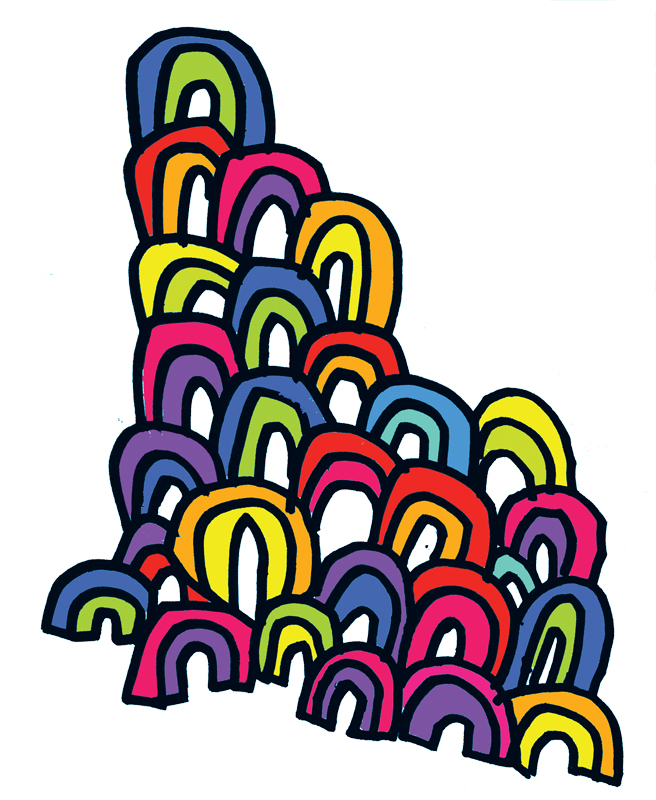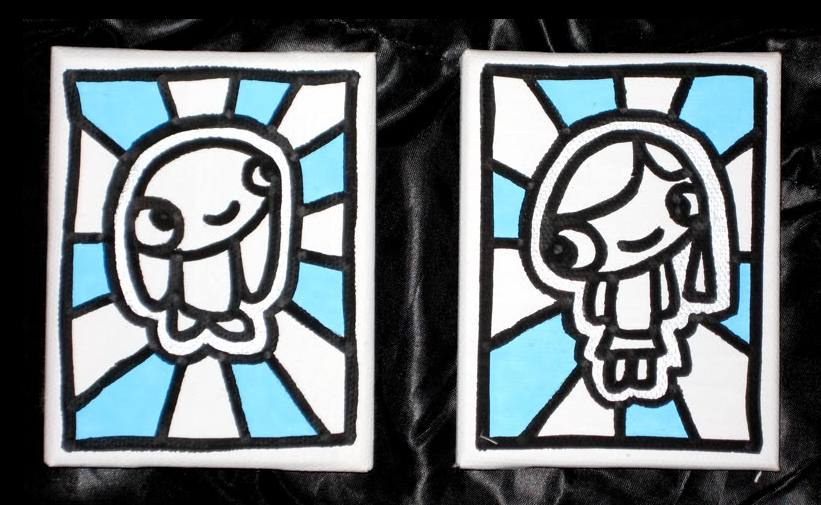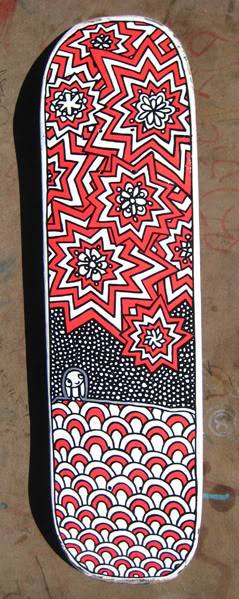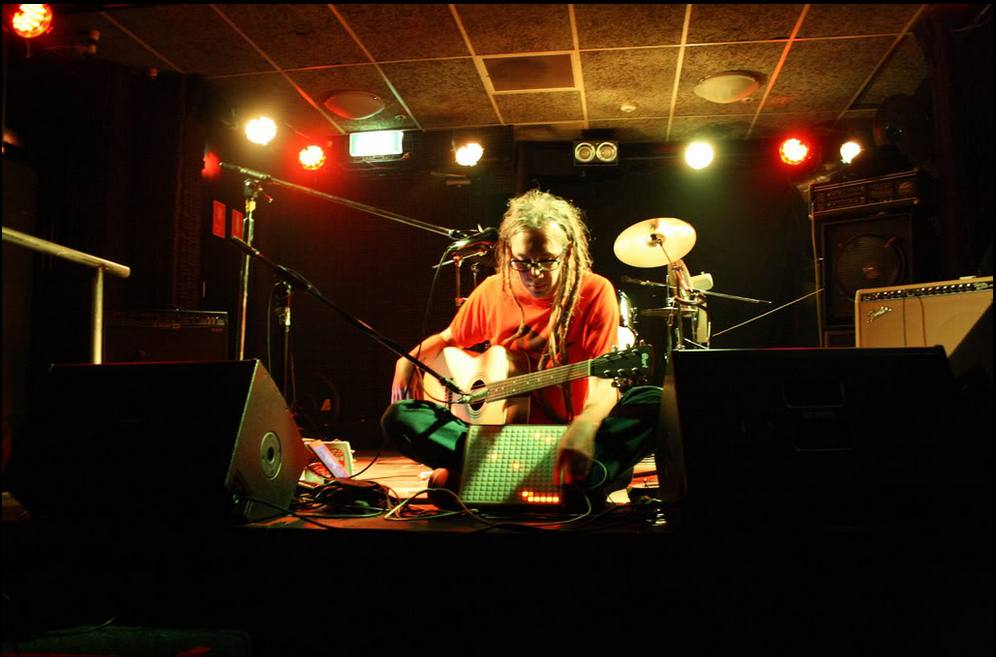Kris Keogh is a name familiar to most involved in the Northern Territory music scene. As a member of hushed indie guitar band Red Plum and Snow and a decade recording and performing as Blastcorp, Kris also maintains an identity as a visual artist – not to mention programmer, producer and DIY promoter.
There’s a space in Darwin co-founded by Keogh in 2006 called Happy Yess that puts on gigs and holds events to foster the local creative community. Keogh creates the promotional material for the events with his characteristic bold colourings, hues so vibrant when observed on a page (or on a screen) they almost seem surreal. “I love colour and I love bold contrasts,” he says.“The brighter, the better. I can save the subtlety and sadness for making music!”
There is definitely no tinge of sadness to the exuberant environments he creates in his visual landscapes: the cover of this edition of Cyclic Defrost being a prime example. “My friend Mel told me I’m quite an obsessive person and I guess she’s right. I’ve been drawing rainbows for months now, thousands of them. I just wish I could see hundreds of rainbows in the sky all day, all at once. I want everything to be hyper-beautiful and I wish the meaning for everything would pop up in the gaps.”
The main tool of his trade is notoriously simple – a Posca PC-5M – a brand that would undoubtedly trigger fond childhood memories of scribbling from anyone who attended a primary school in Australia. “It’s the best texta ever made. The tip is nice and even and it’s actually paint rather than ink.” After crafting the design, Keogh scans it in high resolution and works his magic with the paint bucket tool in Photoshop.
Keogh’s approach to typography is just as organic, with his hand-drawn lettering augmenting, rather than distracting from, its surrounds. “Fonts are lame, I avoid them wherever I can. Every letter is exactly the same every time it’s used, and it’s like the potential beauty of the joins between letters never even existed. It breaks my heart, computers are such amazing creative tools, but, in the case of type, they seem to facilitate just making the world blander.”
What is it about the world of Kris Keogh that makes everything seem so lively, an antidote to this synthetic blandness? Take his website as just one example; it’s filled with a myriad of bold colour, photography, software and a section that’s rather amusingly dedicated to ‘Hair Care Tips’. It leads to a cryptic ellipsis which delivers on the quirky rather than didactic.
Beyond the fantastical characters he paints, resplendent in their intensely saturated colour, this world seems to be an extension of the Japanese “jumping-and-collecting-fruit games” he would play on the Commodore 64 when he was growing up. His childhood was spent in Nhulunbuy, a small mining town in North East Arnhem Land in which he still currently lives. He cites living on Aboriginal land, growing up with indigenous art all around and the aforementioned computer games as his visual influences “in some weird hybrid way.”
“Nyapanyapa Yunupingu, from here, and so many of the Papunya Tula artists like Ray James Tjangala, Yuyuya Nampitjinpa, and Walangkura Napanangka regularly blow my mind. There’s a freedom in indigenous art that floors me. The symbolism is so fluid; a simple circle could represent a person, animal, place, event, relationship, a piece of knowledge or things I couldn’t even imagine. Seeing artists create compositions and tell stories using symbols in this way is totally inspiring.
“All the indigenous artists I really admire also use perspective in ways that would do Picasso’s head in. Things so often seem to be seen simultaneously from above, beside, inside, or from different times or places, and sometimes all at once. It’s a visual language rooted in an ancient culture, yet it seems totally futuristic to me at the same time.”
Having elements run in parallel is also a reflection of the many projects that Keogh himself oversees. Apart from the days spent making music as one half of Red Plum and Snow, building audio processing software in Reaktor and exhibiting his art in Japan, Keogh has just released an album on the New Editions imprint under his own name. It fulfils a long-held desire to work with the harp as a primary instrument, which has made previous appearances in song titles and compositions.
Keogh is also working on a drum machine app in conjunction with software company Nyarlu Labs called shaBOM – Super Happiness Beatbox Mayhem. Somehow, the name seems like it could have only been conceived by Keogh. He says he wanted the app to have a highly beautiful interface, “that you could project while playing live and have it look like a cartoon. All the beats are programmed by you making cute characters bust crazy dance moves, bringing a visual aesthetic into the music making process, an idea that really appeals to me.
“It’s fun to design more visually entertaining ways of creating and performing electronic music, the whole standing behind a laptop checking your email vibe is super boring for an audience. It’s also fun to make a drum machine that has more than the standard features, we’re implementing lots of creative possibilities, stuff like rotational sample swapping, sequence modulation, individual tweaks for timing offsets, scaled tempo ratios and stacks of real-time effects.”
His latest release, Processed Harp Works, Volume 1 is the sort of soundtrack that could easily accompany a Shigeru Miyamoto video game – imagine a Legend of Zelda-esque aural aesthetic married to beautiful imagery on screen. It all came about in 2008, when Keogh moved to Osaka. The force, if you will, of the harp began to take hold. â€ÂFor me, the harp is the most beautiful instrument I’ve ever heard,” he says. “When you hold it against you, it really resonates; it’s gorgeous. One go and I was hooked.”
The story plays out like he’s describing a love affair. Keogh rode his bike across the city each day to practice at the Aoyama Harp studio. “Everyone there was kinda bewildered by me. I was this six foot six, dreadlocked, broke looking Australian that spoke virtually no Japanese. After a few weeks, they realised I was serious about playing and we’re really supportive. They even let me play an Aphex Twin track I arranged for harp for our end of year class concert!
“When I moved back to Darwin, I hunted down the storeroom where the Darwin Symphony Orchestra keep their harp at the university and kept practicing. There was no one else around, so I could bring my studio stuff with me and record. I also spent ages building audio processing software in Reaktor, to mutate the harp and turn my simplistic playing into something more beautiful. Once I had hours of source recordings and the software sorted, I moved back home to Arnhem Land, locked myself away for a few months and made the new album.”
Cut-up fragments of harp strike barriers of delicate white noise on tracks like “I Held On So Tight As Our Whole World Disintegrated”. There are also staccato elements to many of the songs that defy the delicate instrument they were born out of, resonating like a glistening, triumphant accompaniment to any number of ice world levels in the previously mentioned video game analogy. Titles too have this sentimentality about them, and read in order they form the beginnings of a story:
As we said goodbye to everything we ever knew
You sat, looking out, but couldn’t begin to explain
Above Paris, with stars in our eyes
With our own atmosphere
Secretly knowing we’d never be the same
It felt like my future, inside a black & white movie
As meteor showers melted your heart
Frozen, danger ringing in my ears
Your eyes said we were never coming back
I held on so tight as our whole world disintegrated
We were gone, further than forever.
Considering the events that happened after Keogh returned from his time in Japan, perhaps this sentimentality is not so unexpected. The Blastcorp moniker was retired in 2009 with the last release Goodbye – R.I.P (2000-2009), Keogh explains. “I kinda flipped out, had girl trouble and just wanted to ditch everything in my life. The Blastcorp name happened to be something in the firing line at the time. I also felt like I was trying too hard to make music that sounded like music. It had obvious melodies, beats and song structures. With this new harp album, I feel like everything is much more subtle; the rhythms aren’t obvious and the melodies are implied through glitches and changes in texture. It took forever, but I designed a writing workflow where all the chord structures can be built up in a non-linear way by me playing the software. That way I can make all the musical decisions with my ears, rather than all the harmonic rules burned into my head and my muscle memory from years of study and practice.”
As for live performances, Keogh uses a Monome256 which offers a totally different methodology compared to writing and recording. He runs the Monome with a MaxMSP patch called mlr, allowing him to improvise and manipulate the source audio while giving the audience another aspect to look at. “It’s got an awesome visual element to it that engages a crowd. They can actually see you are making the music on the spot and really appreciate that the whole thing could collapse at any minute. It turns one guy pressing buttons into an engaging live show.”
While this all might appear to indicate Keogh’s preference for working under his own volition, he admits that his “control freak tendencies” are tempered by his solo work. If Keogh’s stand-alone compositions could soundtrack a Legend of Zelda game, it makes sense to correlate Red Plum and Snow with a Kirby game – defiantly sweet, but easily able to shift into a full-steam ahead rock-out. “Gretchen, the other half of Red Plum and Snow, is my best friend, so working together is super fun, but can also be pretty intense. But letting go of controlling everything and sharing the creative process is a really beautiful thing, often the songs come out better than either of us could have made by ourselves. Plus getting out from behind all the technology and being in a band means I get to play guitar at gigs and make heaps of noise and feedback, who could resist that? I can’t help it, I just wanna do everything, all at once, forever!”
Processed Harp Works, Volume 1 is out now on New Editions. Red Plum and Snow’s Brightest Beginnings is out now through Bandcamp. shaBOM will be released in the App Store in the coming months. Kris Keogh’s website can be found at www.kriskeogh.com







